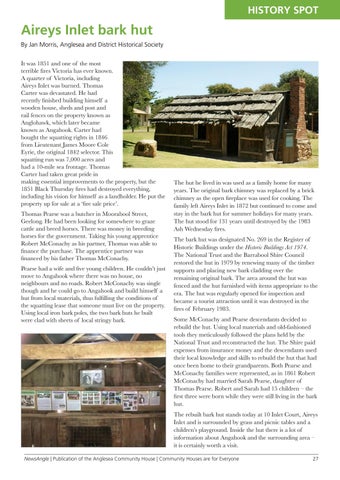HISTORY SPOT
Aireys Inlet bark hut By Jan Morris, Anglesea and District Historical Society It was 1851 and one of the most terrible fires Victoria has ever known. A quarter of Victoria, including Aireys Inlet was burned. Thomas Carter was devastated. He had recently finished building himself a wooden house, sheds and post and rail fences on the property known as Anglohawk, which later became known as Angahook. Carter had bought the squatting rights in 1846 from Lieutenant James Moore Cole Eyrie, the original 1842 selector. This squatting run was 7,000 acres and had a 10-mile sea frontage. Thomas Carter had taken great pride in making essential improvements to the property, but the 1851 Black Thursday fires had destroyed everything, including his vision for himself as a landholder. He put the property up for sale at a ‘fire sale price’. Thomas Pearse was a butcher in Moorabool Street, Geelong. He had been looking for somewhere to graze cattle and breed horses. There was money in breeding horses for the government. Taking his young apprentice Robert McConachy as his partner, Thomas was able to finance the purchase. The apprentice partner was financed by his father Thomas McConachy. Pearse had a wife and five young children. He couldn’t just move to Angahook where there was no house, no neighbours and no roads. Robert McConachy was single though and he could go to Angahook and build himself a hut from local materials, thus fulfilling the conditions of the squatting lease that someone must live on the property. Using local iron bark poles, the two bark huts he built were clad with sheets of local stringy bark.
The hut he lived in was used as a family home for many years. The original bark chimney was replaced by a brick chimney as the open fireplace was used for cooking. The family left Aireys Inlet in 1872 but continued to come and stay in the bark hut for summer holidays for many years. The hut stood for 131 years until destroyed by the 1983 Ash Wednesday fires. The bark hut was designated No. 269 in the Register of Historic Buildings under the Historic Buildings Act 1974. The National Trust and the Barrabool Shire Council restored the hut in 1979 by renewing many of the timber supports and placing new bark cladding over the remaining original bark. The area around the hut was fenced and the hut furnished with items appropriate to the era. The hut was regularly opened for inspection and became a tourist attraction until it was destroyed in the fires of February 1983. Some McConachy and Pearse descendants decided to rebuild the hut. Using local materials and old-fashioned tools they meticulously followed the plans held by the National Trust and reconstructed the hut. The Shire paid expenses from insurance money and the descendants used their local knowledge and skills to rebuild the hut that had once been home to their grandparents. Both Pearse and McConachy families were represented, as in 1861 Robert McConachy had married Sarah Pearse, daughter of Thomas Pearse. Robert and Sarah had 15 children – the first three were born while they were still living in the bark hut. The rebuilt bark hut stands today at 10 Inlet Court, Aireys Inlet and is surrounded by grass and picnic tables and a children’s playground. Inside the hut there is a lot of information about Angahook and the surrounding area – it is certainly worth a visit.
NewsAngle | Publication of the Anglesea Community House | Community Houses are for Everyone
27












